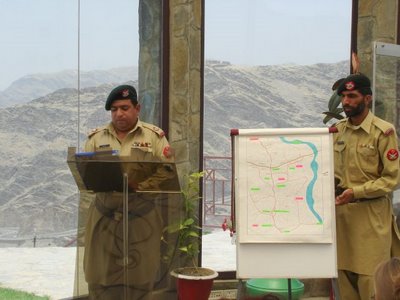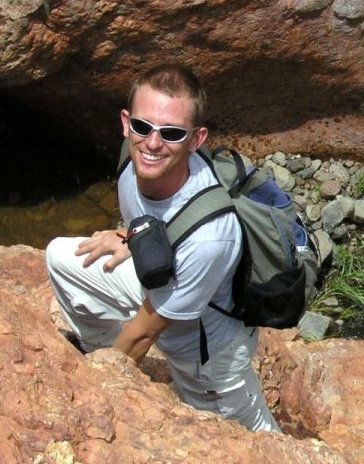Sorry there's been no update in a while. We've been working hard to finalize all the information products that UNJLC produces before our operation shuts down at the end of July. Our field staff have been struggling up ever more remote roads to try and get as many of them as possible into the Quake Zone Road Atlas that we are publishing just before we go. I've been spending my days doing cartography and design work on the atlas and meeting with the printing company to make sure everything ends up looking like I planned. Making the transition from computer files for small volume print runs on office inkjets to large volume four-color offset printing is never easy. There's always a font that doesn't transfer or a graphics conversion that makes smooth lines jagged. I expected the same task here to be doubly hard with language and technology barriers, but it hasn't been so far.
The printing company is in light industrial area of Islamabad and looks pretty much like any other commercial printing plant I've ever been in. The pre-press guys there run the same software as any other graphic design shop, although here I think all of them are illegal copies which you can buy in shops for about $4 instead of $500 for a typical graphics package (or $8000 for the GIS software that we use).
There was a bit of a lull a few weeks ago, and I was able to make a couple of weekend trips: one to the Afghan border and one to the Indian Border. Very, very different places. The first was a trip by steam train up to the famous Khyber Pass. You wouldn't think a train ride to the border of Afghanistan would be a big tourist draw. And in comparison with Disneyworld, I guess it isn't, but there's enough interest for some local train enthusiasts to make the trip from Peshawar to the Khyber Pass every two months or so.

The train is maintained by an enthusiast who started the tourist trips as a way of funding the maintenance of the trains.
Peshawar is a colonial town, with lots of crumbling old British buildings to prove it. It's where lots of goods smuggled from Afghanistan (cars, cloth, opium, guns) end up. It has a wild west feel to it, but still is basically a part of Pakistan that the federal government controls. Heading west from there along the railway, though, we find another world. The dusty plain is dotted with little settlements made up of family compounds with high, featureless adobe walls. From the narrow streets that zig and zag between the compounds children come running to see the train and wave at us. Occasionally a burka-clad woman peeks out from a gate.


I felt a little weird making photos of people as I sped by on a train full of very privileged white people, but then I saw a local guy who was making a picture of us with his mobile phone.
The mountains approach, and the train passes through a narrow gorge to begin climbing up to the pass. We have a steam engine at each end and two passenger cars in between, full of mostly humanitarian workers and diplomats. There are two engines because the train has to reverse itself twice to make it up the steep valley. Rather than build a long looping railway grade, the engineers put in two switchbacks that form the points of a letter "N". At each point, the train stops and reverses direction to continue on.

It's easy to imagine any one of a dozen conquerors (some successful, some not) who used the Khyber pass as a gateway into the subcontinent marching down these valleys with their armies. In many spots, it looks like not much has changed.
This part of Pakistan is fully under control of the Pakistani government. We are told their control extends at least 100m (that's meters, not miles for you Americans) on either side of the railway. The railway right-of-way was formally ceded to the British by the local tribes when the railway was built in the 1920s. Off this right of way, tribal law prevails. It's a system somewhat like the Native American Reservations in the US, except the tribes here retained a lot more power.

The further up the mountains we climb, the higher the walls of the compounds. We stop for tea at an old fort and later, standing on the Khyber Pass itself, we get a briefing from the commander of the Khyber Rifles, the Pakistani force that monitors the border. The border is far below us in the valley, but this is as close as we are going to get.

The briefing. The actual border is down the valley out of the left of the frame.
There is a tarmacked highway here, which is busy with commerce and the return of refugees of Afghanistan's long abuse at the hands communist, capitalist, and religious zealots. At the peak, there were over 4 million Afghan refugees in Pakistan, some of them here for decades. That number is decreasing now as some tentatively head home in hopes that Afghanistan will hold itself together.

One of our stops involved a marching band. I don't really know the full tale of how this little bit of colonial color survived, but like the train itself, the British influence in Pakistan pops up in surprising ways.
We are treated to lunch and tribal dancing performances at the Khyber Rifles Officers' Mess, another bit of colonial architecture complete with dark wood halls covered with photos of past commanders and visiting dignitaries. There are peacocks in the garden. The tribal dancing is interesting, each tribe having its own dance form. Only men dance; the women are kept mostly shielded behind those high compound walls. The dancing involves a lot of very athletic spinning, which is impressive, and a lot of surprisingly feminine scarf waving, which is a little creepy.

Swords and scarves are a weird mix.
Ok, I'm going to be a bit impolitic here. This male dancing business is another example of how the culture here seems to have painted itself into a corner with its restrictions on women. The women can't dance as it would violate all sorts of cultural taboos. A Pakistani man in these tribal areas could be killed for even looking at a woman (dancing or otherwise) to whom he is not related, she might get killed too for having been defiled by his gaze. So the men do the dancing, and you end up with mustachioed men in pantaloons waving scarves around. It doesn't really do much for anyone.
Now you could argue that I'm judging Pakistani sexual politics by my own very post-sexual-revolution standards, which of course I am. But no matter what standard you use, the outcome here isn't a happy one. I've talked to enough men here to know that they are all pretty sexually frustrated, their attitudes toward women seem pretty hypocritical. Their ideas about how sexuality works in the west are quite distorted from reality, which means that western women here get a steady stream of weird inquiries from Pakistani men. My friends in the field tell me that rape of girls in the rural areas is common. All in all, it feels pretty unhealthy, which is what you get when you let religious people tell you what you can and can't do with your private bits. Americans, don't say I didn't warn you.
Ok. Done. Rant over. It gets to you after a while, you know. And thanks to the internet, I can vent to the whole world.
That's enough for now. I'll write about the Indian border visit another time. For those of you who are wondering what my plans are, I'm here working in Islamabad until the end of July. Then Jasper, Susan, Dave (friends from Eritrea), and I are going trekking in the mountains here in August. We're going to try to summit a 6000m peak. After that I go home for a week, then it's off to a new post with UNJLC in South Sudan for a few months. Similar work there: trying to map infrastructure to support the ramped up relief effort that is underway. Did you know that the largest human migration in decades is underway as millions of people displaced by the civil war in Sudan return home now that the war is over? There's not much for them to return to, so lots of humanitarian aid is flowing to help them get their lives restarted.
